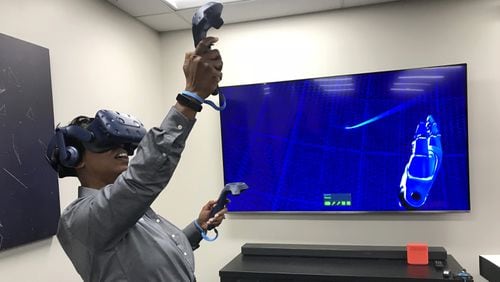Lockheed Martin pulled up the curtain on a new innovation lab, showing off 3D printers, virtual and augmented reality headsets and a robotics lab meant to encourage its employees to experiment.
The 6,500-square-foot lab, which sits near the eastern perimeter of the defense giant’s Orlando-based Missiles and Fire Control campus, will also be used as a recruitment tool, as Lockheed competes in a highly competitive battle for skilled workers.
“It’s a place people want to work at,” said corporate innovation manager Chad Harper, who is based in Dallas and also helped open the company’s innovation lab there. It’s “having the ability to have the freedom to experiment and explore and also do your day job.”
Lockheed Martin has 7,000 employees in Orlando, and that number is expected to grow.
“This area is great and there is a lot more competition for talent,” engineering vice president Tom Mirek said. “One of my jobs is to attract them to Lockheed Martin. (The innovation center) benefits this area by keeping students we have here in the area with high-paying jobs instead of going west or going north.”
A stroll through the lab during its coming-out party gave a glimpse at what the company thinks could be the future of innovation, with 3D-printed hardware sitting alongside a 3D-printed bullfrog and bottle opener.
On the other side of the room, employees tinkered with an augmented reality headset, just next to another worker playing a fighting game using virtual reality.
In another room, a table is lined with drones as room leaders talk about how an exoskeleton built by an employee — known as ONYX — now has dedicated space in the facility for future development.
The area is meant to encourage experimentation, said Travis Coomer, the company’s vice president of engineering and technology.
“We are expecting spectacular successes,” he told a small crowd at the facility. “We are expecting spectacular failures.”
Lockheed anticipates that the new facility will help the company create new patents and win multimillion-dollar contracts.
Any intellectual property created there will belong to Lockheed, although Harper said at least one project created in its Dallas location was in a sector Lockheed does not operate in.
The creator of that was allowed to take his intellectual property outside of the company, according to Harper.
“We wanted to create a space where people can imagine the future and have the tools to … test ideas,” said Frank St. John, Missiles and Fire Control’s executive vice president.
The layout of the space includes five dedicated laboratories, each sporting its own kind of next-generation technology for workers to play around with.
These include a computing test environment, where workers can create and test applications; a lab that includes access to AR, VR, high-powered computers and 3D printers; a robotics test bay; an animation lab that allows quick visualizations of concepts; and a sensor, optics and laser testing site.






